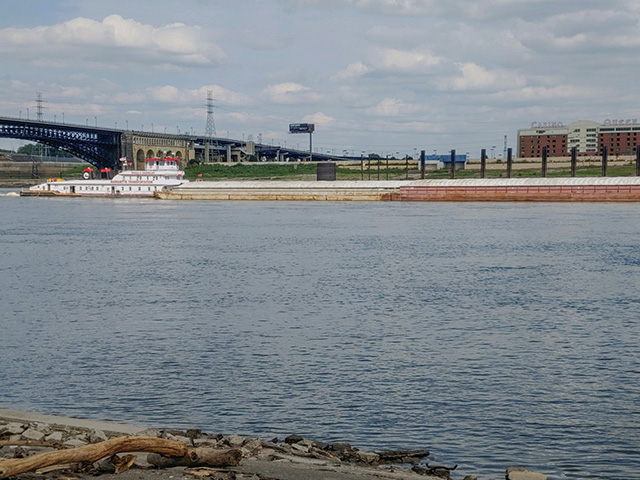Cash Market Moves
Lower Mississippi River Getting Thirsty
While much of the Upper Mississippi River hibernates for the winter, barges continue to move down the Illinois River and then on to St. Louis, Missouri, and the Lower Mississippi River to the Gulf. Good river conditions are key to getting corn, soybeans and other commodities to the Gulf in a timely manner for export. Low water conditions, if they persist, can be troublesome.
In its weekly Grain Transportation report, USDA noted that, for the week ended Jan. 16, barge grain movements totaled 914,831 tons, 40% higher than the previous week and 76% more than the same period last year. During that week, 563 grain barges moved down river, 154 barges more than the previous week. There were 968 grain barges unloaded in New Orleans, Louisiana, 9% fewer than the previous week.
American Commercial Barge Line noted on Jan. 22 that, "While fog in the Gulf caused approximately four to six hours of stoppage to transit and fleet work, there were good operating conditions otherwise on the Lower Miss and Canals for the week." In other words, so far so good.
On Jan. 25, NWS North Central River Forecast Center showed some promising moisture to give temporary relief. "A low-pressure system lifting though the Southern and central Plains will allow snow to spread out across the central U.S., spanning from Nebraska to Kansas to parts of the Great Lakes, Ohio Valley and Mid-Atlantic regions," reported the NWS.
DTN Senior Ag Meteorologist Bryce Anderson added, "A major winter storm Monday and Monday night may drop 12 to 18 inches of snow in eastern Nebraska-southwest Iowa (record amounts maybe in these locales); around a foot in central-eastern Iowa; and 4 to 8 inches in northern Illinois."
The NWS noted in its precipitation forecast that, a little farther south, with the system bringing the snow, scattered to widespread showers and thunderstorms are expected. Periods of moderate to locally heavy rainfall are expected in parts of the Mid-Mississippi Valley and the Tennessee and Ohio valleys. Here is a link to the NWS Advanced Hydrological Prediction service: https://water.weather.gov/….
P[L1] D[0x0] M[300x250] OOP[F] ADUNIT[] T[]
Looking ahead in the current NWS Lower Mississippi River summary, many U.S. rivers will be falling lower by the end of the month, even with the current rain forecast. As far as the snow, it becomes more of a factor in the spring when the melt reaches the rivers. It is important to note the water content of the snow that falls, i.e. powdery versus heavy wet snow. According to Accuweather, powdery snow contains less water; on average, 5 inches of dry snow will melt to only 0.5 inch of water. Wet snow, on the other hand, can equal up to an inch of water for every 5 inches of snow.
Currently, according to the Jan. 25 U.S. snow depth map released by the NOAA Office of Water Prediction (OWP) National Water Center, seasonal accumulation of snow cover is the lowest for this date in nearly 15 years at this time (https://www.nohrsc.noaa.gov/…).
The latest Midwestern Regional Climate Center Accumulated Winter Season Index (AWSSI) map shows that many of the states along the U.S. river system have had mild winter conditions. Of course, it's only January, and things could change. But the lack of snowfall up to this point along the river system is noticeable (https://mrcc.illinois.edu/…).
The low water conditions on the Mississippi River have persisted since fall 2020. Going back to early October 2020, the Mississippi River level at St. Louis was nearing 1 foot above zero gauge, and the Mississippi River in Memphis, Tennessee, was 2.5 feet below the low stage of 5 feet. Currently, the level at St. Louis is expected to reach the 1-foot stage next week, and Memphis is currently at 0.7 below zero gauge.
While barges have been able to move smoothly the past few weeks, if river levels continue to fall, that could create slowdowns and/or stoppages if areas in the Lower Mississippi River need to be dredged due to shoaling, or worse, if barges are grounded in extreme low-water spots.
NWS Hydrograph Mississippi River St. Louis, Missouri: https://water.weather.gov/…
NWS Hydrograph Mississippi River at Memphis, Tennessee:
NWS Lower Mississippi River summary:
https://forecast.weather.gov/…
Mary Kennedy can be reached at mary.kennedy@dtn.com
Follow her on Twitter @MaryCKenn
(c) Copyright 2021 DTN, LLC. All rights reserved.



